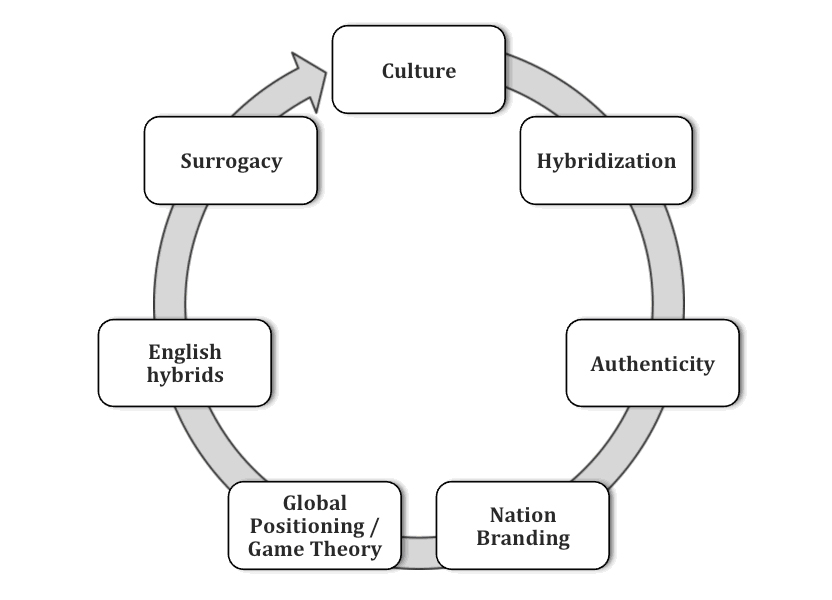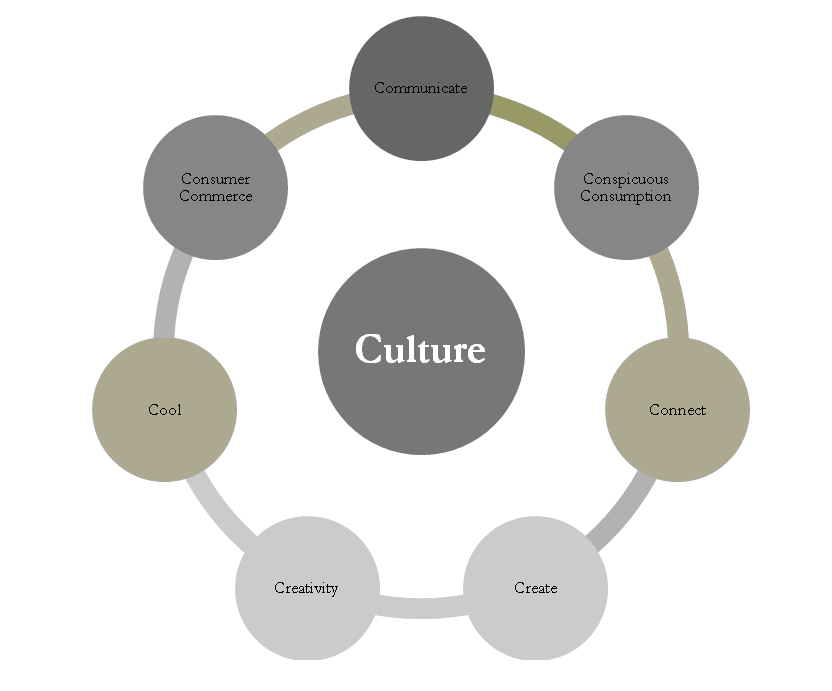The exciting new wave of Global brand culture and consumerism embodies the modern-day phenomenon of collective individualism and hybrid personalities – which connects people across nationalities and ethnicities using the language of brands. This article highlights some of the key trends and offers further insight, from a branding and anthropological perspective.
Brands and national identity are on the tip of everyone’s tongues. They are language shapers and meaning creators. But with the rise of global brands, are we all starting to think, feel, speak and behave in the same way?
de Mooij (2011) observes that,
“In practice, notwithstanding the worldwide reach of television and the internet, in many people’s lives, in consumption or entertainment habits, be it music or sports, the people of different nations continue to have different habits, tastes, and loyalties. Instead of causing homogenization, globalization is the reason for the revival of local cultural identities in different parts of the world.” (p.5).
This view challenges Levitt’s (1983) rational perspective of global markets, where Levitt suggests that technology leads to the homogenization of consumer wants and needs – as they will crave high-quality and low price standardized products over customized high-price offerings. Usunier (1996), also argues that there exists no empirical evidence to show homogenization of tastes or the appearance of universal price-minded consumer segments. Instead,
“Convergence at a macro level (e.g., convergence of GNI [gross national income] per capita) does not necessarily imply convergence of consumer choice. As people around the globe become better educated and more affluent, their tastes diverge” (de Mooij, 2011 p.6).
Global brands spearhead conspicuous consumption and consumerism, and with further technological developments, it is now possible to create more customised, high quality and low-price offerings – which some have termed ‘affordably luxuries’. Brands can now be both global and local – depending on the space, time, context, and engaged stakeholder.
Another key development has been the ascendance of English language. English in particular, because it is the global language of business. However, a key question is what sort of English – as most people who speak English have it as a second non-native language. Also, other languages continue to influence English. Collectively, they all express culturally specific patterns, which are embedded in contextual situations.
Evidence points to the strongest global brands being known according to strong linkages with English language text and English derivatives, shaped by non-English language natives. Examples of colloquial terms are: Americanisms, BBC English, Business English, Engrish (sic), Indian English, Jamaican Patois, and Malaysian English amongst others. Furthermore, marketers are known to break the rules of language – abandoning punctuation, grammar and capitalisation in places. Language is subject to context, group and rapid fashionable change. What may be cool for some, or today, may not be the case in the future.
But with the rise of English, does this mean that everyone is becoming ‘Westernized’?If this is the case: does it mean that the ‘West is best’, and Western brands are set to dominate – with other non-native English speaking nations moving away from and even harming their culture? Or is it that ‘other’ nations are engaging in a hybridized form or collaboration, which will lead to wealth creation and an eventual swing away from Western dominance?
I would argue that East/West thinking harms brand development – as it implies separation. And more importantly, by inference it supports the idea that the strongest brands, media platforms and educational systems lie outside of the hands and inception of the majority of the non-English native world – which profiles the majority almost as being intellectually impoverished.
The following model is one that I’ve used to outline an alternative perspective on the process of global brand culture and communication.

Here, I argue that understanding, mediating between and harmonizing national identities is key – without diluting them. This creates authentic propositions, which are rooted in transient and transcendent cultural heritage.
Prior to my papers (Wilson et al, 2009; 2012), the term ‘surrogacy’ had scarcely been used in connection with strategic brand management approaches. Where it was, the term had been used to describe a new product or service brand, which draws from another brand within a corporate portfolio. The difference in the definition here is that surrogacy is used to describe consumption. We argue that this consumption, which demonstrates surrogacy:
– Applies to brands
– Applies to their consumers
– Is the consumption of culture which creates social networks and communities
– Offers a means to generate social capital
– Seeks the humanization of brands
– Is a ratification of authentic and credible cultural-centric brand successes.
Consumers and brands move towards embracing temporal identities, culminating in an adopted national identity. They are creating an alter ego through the adoption of another nation’s brand. The intention being that this represents a facet of their emotional state. In doing so a long-term affiliation with an ‘other’ nation should evolve and eventually assimilate itself into the consumer’s and brand’s host culture, in a fluid manner.
The Globally Branded Generation
So what of the future? Be prepared to witness the reigns being taken by a generation of informed, self-mediating, empowered and technologically savvy branded urbanites. For them, heritage is progressive: they embrace the eradication of hierarchy and knowledge that simply translates to power. Instead: diverse networks; the sharing and adaptation of information; and ultimately the positioning of co-brands, which link with other spheres of life, offer more of a pull. These consumers carry brands with them, pollinating cultures, brands and corporations – like bees carry pollen to flowers and hives.
Furthermore, consumers don’t just consume, they look to do two things. Firstly, they share – as a form of social capital and gains from the idea of reciprocity. Evidence can be seen on YouTube where consumers are reviewing their purchases, sharing fashion tips and entertainment. Secondly, where possible, consumers seek to monetize what they own. Consumers think about whether this sharing can lead to a revenue stream, future career, sponsorship opportunity, or if items can be sold in online auctions. This doesn’t mean however that consumers are spending more money on everything. Some spending on designer labels has increased; and during the recession ‘small luxury’ purchases like chocolate and lipstick have increased. But equally, spending on movies and music has declined in favour of illegal downloads. Therefore, the globally branded generation look to get the best value for money, from a holistic standpoint – where value equates to social capital and emotional well-being.
We are seeing how stakeholder networks and Web2.0 are driving increasingly dynamic communications, which are both influencing and engaging more parties. The result is the creation of ‘collective individuals’, who converge around culturally embedded and ‘human’ brands – and support the idea of Global identities, which enhance local cross-border sub-cultures. In the face of this, Transformational Leadership will be a powerful tool for shaping the thoughts, feelings and actions of empowered clusters of engaged stakeholders.
Moving forward, brand managers and consumers seem set to gravitate towards greater collaborative consumption and new ways of interpreting what brands mean – and how they shape the language and meaning of life in the here and now. The following model summarises the emerging brand youth culture as I see it:
The 10Cs of Brand Youth Culture

The Hip hop Grunge legacy
In the 90’s, Hip hop and Grunge music rose as two global phenomena that crossed ethnic, socio economic and national identities. To their followers, they were two sub-cultures, which were more than a music form. Also, in some places later on, each began to influence each other with cross-over groups. Hip hop originated from ethnic America, whist Grunge from ‘white’ America. Central to both was the role of the media and entertainment industry. Both movements were held to be a state of mind, a way of life, a culture, a language, and a social commentary. As global collaborative phenomena, they have stretched audiences’ cultural ethnicity, so that consumers feel comfortable with drawing from wide sources – seeing them flip-flop between the ‘white’ and the ‘ethnic’. So much so, that these terms have little meaning. Also initially, Hip hop and Grunge were categorized as forms of rebellion and separation. However, with more understanding, it can be argued that they represented a signal of redefining and asserting what ‘their view’ was of wider society. Now, their relative successes signalled commercialization and wider acceptance within the establishment. These I argue have laid the blueprint for global brand excellence: culture references and authenticity, which are both evolutionary and revolutionary – but at the same time organic, fluid and human.
References
de Mooij, M. (2011), Consumer Behavior and Culture: Consequences for Global Marketing and Advertising, (2nd Ed.), Thousand Oaks, CA: Sage Publications, Inc.
Levitt, T. (1983), “The globalization of markets”, Harvard Business Review, May-June, pp.2-11.
Usunier, J-C. (1996), “Consommation: Quand global rime avec local (Consumption: When global rhymes with local), Revue Française de gestion, 110, pp.100-116.
Wilson, J.A.J. (2011a), “New-School Brand Creation and Creativity – lessons from Hip-Hop and the Global Branded Generation”, Journal of Brand Management, Vol.19 Issue 2, Oct/Nov, pp.91-111.
Wilson, J.A.J. & Liu, J. (2012), “Surrogate Brands – The pull to adopt and create hybrid identities – via sports merchandise”, International Journal of Sport Management and Marketing, Vol.11 No.3/4, pp.172-192.
Wilson, J.A.J., Liu, J. & Fan, Y. (2009), “Surrogate Brands – The pull to adopt an ‘Other’ nation; via sports merchandise”, Academy of Marketing Annual Conference, July 7th-9th, Leeds Metropolitan University, UK.